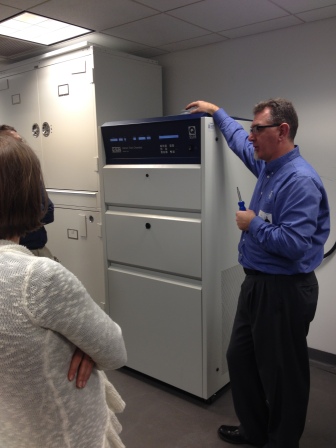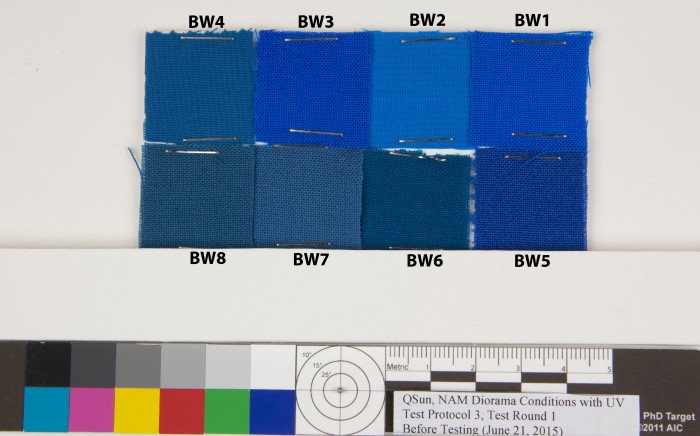Q-Lab Corporation, manufacturer of the Q-SUN Xe-3 accelerated aging chamber, promotes this machine as “the simplest, most reliable, and easiest to use full-sized xenon arc chamber available.” Before purchasing ours in February 2014, we began making upgrades to water and electrical systems in our lab to meet its basic requirements. Perhaps naively, we had planned to install the chamber and begin our testing promptly once those upgrades were complete. Throughout following months, we encountered a series of unexpected challenges in the set up and operation of our new chamber. This is the first in a pair of posts that will introduce the Q-SUN Xe-3, its capabilities and some of the theory behind its use, explore the challenges we have had, and suggest some key issues that you might consider when planning to acquire a large piece of new equipment for your laboratory.
THE Q-SUN ACCELERATED AGING CHAMBER

Q-SUN Xe3 Accelerated Aging Chamber with Q-Lab training specialist Alan Boerke for size comparison. AMNH/B. Nunan
PART 1: GETTING UP TO SPEED
Much to the disappointment of some of our curious colleagues in other departments who wondered what one does with an accelerated aging chamber, the Q-SUN Xe-3 can not be used to expedite troublesome developmental phases in your toddler, nor be run in reverse to reunite you with your youth. Too bad. Instead, this machine is used to rapidly reproduce the damage to materials that is caused by light, temperature, and humidity in real environments over longer periods of time.
The tester is a bit bigger than a refrigerator, and contains three powerful xenon arc lamps that expose samples to bright, daylight-imitating light inside of a compartment roughly the size of an oven. The spectrum of light produced can be adjusted with the installation of various filters above the sample compartment. Light output is measured in irradiance (W/m2), and can be controlled at either 340nm (ultraviolet) or 420nm (visible) depending on what filters are in use. The tester also maintains set points for relative humidity, chamber air temperature, and the temperature of a black panel placed inside the sample compartment.

Q-Lab training specialist Alan Boerke discusses the Q-SUN aging chamber with project conservators and other conservation scientists from neighboring NYC institutions. AMNH/B. Nunan
On March 10, 2014 the American Museum of Natural History (AMNH) hosted a training session on accelerated aging and use of our new Q-SUN Xe-3 with Alan Boerke, Technical Sales and Training Specialist at Q-Lab Corporation. The training was attended by selected museum staff and colleagues from Yale’s Institute for the Preservation of Cultural Heritage, the Metropolitan Museum of Art, and the Museum of Modern Art, as well as students from New York University’s Institute of Fine Arts Conservation Center.
Accelerated aging makes use of the principle that exposure to high intensity light for a short time can produce deterioration similar to that caused by low intensity light over a longer time. However, in order to correctly interpret one’s results, one must understand that for many reasons, accelerated aging does not occur in a way that is strictly reciprocal. In part this is due to the inability of any aging chamber to exactly replicate every aspect of real-world exposures: wet/dry, thermal, or light/dark cycling, the spectrum of incident light, and the presence of air pollutants, dust, or adjacent materials may be impossible to simulate. This non-equivalence is also a consequence of thermal chemistry that unfolds simultaneously alongside light damage, but can’t easily be differentiated from it or accelerated proportionally.
Alan emphasized benchmarking as a way of managing this problem. To create a benchmark, materials aged in real-time are used to define the mode and extent of change taking place over a known duration. When a comparable degree of change is observed in the accelerated test, a correlation factor can be identified to be used in calculating an approximate relationship between accelerated and real-time aging. However, benchmarking has some obvious drawbacks, not the least of which is that a material that ages well may take many many years to fail in a real-world exposure environment. If one is conducting accelerated aging on that material, it’s usually because one needs information promptly and can’t afford to wait.
The success of this approach depends on the selection of a standard that exhibits deterioration behavior similar to the samples being tested- both in the real world and accelerated aging environments. However, since the samples being tested have unknown aging behaviors one standard is usually insufficient. So instead of choosing a single standard, it is better to select a series of standards that will hopefully bracket the behavior of the samples. For lightfastness testing, a common set of standards is the Blue Wool scales, wool swatches dyed with eight different dyes that exhibit a range of different lightfasnesses. By including the Blue Wool scales in our accelerated tests we can determine which of the eight standards our samples behave most similarly to.

Blue Wool scale assembled by the team using blue wool reference standards 1-8 obtained from SDC Enterprises Lmtd and mounted onto card stock. A new Blue Wool reference scale will be used with each test round. AMNH/F. Ritchie
Our training session also included a discussion of other factors that could affect the results of our testing: the color and cleanliness of the sample, whether it is mounted at an angle, or over a backing board, and its height inside the sample compartment; variations in sample handling and measurement technique; breaks in our test cycle for sample measurement; and the age of the xenon lamps. Getting repeatable results hinges on limiting variation in these influences.
We concluded with a tutorial in which Alan showed us all the basics for running and maintaining the machine: how to load and rotate samples, install and calibrate lamps, change light filters, and program the desired parameters.
With all of this new knowledge in hand, we promptly began the process of translating our research plan into an actual method for mounting and testing our dye samples. Very quickly we observed that doing so would not simply be a matter of plugging in the Q-SUN, programming the ASTM D4303 test parameters, and pressing the ON button. Many unanticipated challenges were yet to come…

Conservation intern Ersang Ma prepares to calibrate the Q-SUN lamps, according to procedures learned during the one-day training session by Q-Lab. AMNH/B. Nunan

Pingback: Accelerated Aging Chamber, Part 2 | In Their True Colors
Thanks for this post. We are thinking of proposing to invest in such a system. What hit me is the additional cost beyond purchase for consumables. While it is obvious that such a budget is needed, would you say you are spending in excess of what one would think is needed for an ageing chamber. How much (as a guide) would be needed to maintain it? Thanks, Matthew
LikeLike
Hi Matthew,
Demand has not outstripped our anticipated budget, but it is something to consider carefully. In our QSUN, Xenon lamps are used for 1500 hours. Presently they cost approximately $150 each. The unit requires three lamps. The length of our test cycle dictates that we change the lamps every three cycles. Water is another significant expense. For our E-pure system, a cartridge set costs roughly $500. The life of that set is dependent on the water quality at your site, whether you have pre-filter(s) in place, the settings on your instrument (high humidity = high water consumption), and the ambient environmental conditions in your workspace. We replace our cartridge set every 2-3 cycles. However, the situation could be different at a site that has a bulk source of deionized water on hand, or with a different filtration system. The water consumption has been difficult to estimate for a variety of reasons related to both the test chamber and the water system. I would recommend a close reading of the equipment specifications, as much advance discussion and research as possible, and finding some knowledgable professionals in your area who can work with you on the water supply side if need be.
LikeLike
Thanks a lot for your insight on the consumables side of the argument. It surely needs careful thinking based on the specifications and workload/projections of each lab. Greatly appreciated! Best wishes in your endeavours.
LikeLike
The machine looks cool. And I would like to exchange more information about Light & Weather Fastness Tester, which may help your cutting a lot. Please go to:
testextextile.com/product/light-weather-fastness-tester-tf420/
LikeLike
Pingback: Water, water, everywhere | In Their True Colors